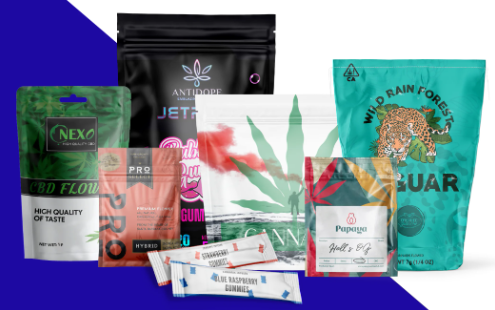Weed Bags: How to Stand Out in the Legal Cannabis Market
In the legal cannabis market, packaging is the first line of defense and the first dialogue between brands and consumers. It must strike a balance between stringent child safety (CR) regulations, the need to maintain a barrier to protect product potency, and fierce market competition.
However, this balance is not easy: Ignoring compliance can lead to product removal and regulatory penalties, while focusing solely on compliance without market appeal can lead to lost customer attention and ultimately damage the brand.
As a solution provider specializing in customized flexible packaging, MTPAK is well-suited to this market demand. Below, we will further analyze the key points of legal cannabis packaging to help you find a solution that balances compliance with market competitiveness.
What is a professional weed bag?
Specialized hemp packaging bags are engineered flexible packaging solutions that go beyond standard plastic bags, integrating multiple key features to meet legal and market requirements. Their core design focuses on three key pillars: child-resistant (CR), product protection (light, oxygen, and moisture barriers), and regulatory compliance (such as labeling requirements).
Unlike general-purpose packaging, these bags must pass specific testing standards (such as USP <671> or ASTM D3475) and adhere to strict local regulations regarding material selection, sealing performance, and printed information.
What core materials and properties do weed bags require?
Cannabis flowers and concentrates are extremely sensitive to oxygen, moisture, and light. These factors can cause tetrahydrocannabinol (THC) degradation and terpene volatilization, affecting potency and flavor. Therefore, packaging materials must provide high-barrier protection.
l Oxygen barrier: Ethylene vinyl alcohol copolymer (EVOH) or polyvinylidene chloride (PVDC) is typically used as an intermediate barrier layer to minimize oxygen transmission rate (OTR).
l Moisture barrier: Materials such as polyethylene (PE) or polypropylene (PP) provide an excellent water vapor barrier, protecting the product from moisture and mold.
l Light shield: Opaque materials or metalized films (such as aluminum foil) are used to block UV rays and slow photodegradation.
In most cases, we use multi-layer co-extruded film structures, such as PET/AL/PE or MAT-OPP/EVOH/PE, to achieve light-blocking, high-barrier, and heat-seal properties.
What are the special requirements for printing and labeling on weed packaging?
In a highly competitive market, a unique brand design is the key to standing out. This requires high-quality printing services:
l Printing Technology: Utilizing gravure printing, we can accurately reproduce complex brand patterns, signature colors, and gradient effects.
l Surface Treatment: Available matte, glossy, and spot UV effects enhance the packaging's quality.
l Customization Options: We support a variety of bag designs, including custom windows and custom-shaped bags, enhancing product presentation and uniqueness.
Furthermore, the printed content on packaging is a key focus of compliance inspections.
Typically, it must include: product name and brand information, cannabinoid content (THC/CBD percentage and total milligrams), batch number and production date, authorized use symbols (e.g., adults only), and an ingredient list with government health warnings (for edible products).
Why is Child-Resistant (CR) Design Essential?
Child-resistant packaging is mandatory in most legal markets. CR design is primarily achieved through two methods:
l Reusable zip-lock bags: These use a special zipper pull design that requires a certain amount of force and skill to open, thus meeting CR standards.
l Disposable tear-off packaging: These use methods that may be difficult for children to open (e.g., requiring specific tearing) but are generally acceptable for adults.
l All CR packaging undergoes third-party laboratory testing to ensure compliance with regulatory requirements in the target market.
How to make Weed Bags both environmentally friendly and safe?
With evolving regulations and rising consumer awareness of environmental issues, more cannabis brands are adopting recyclable, biodegradable, or bio-based packaging materials. Currently, eco-friendly weed bags include:
l Recyclable PE/PE construction (single material for easy recycling).
l PLA or PBS bio-based film layers (industrially compostable).
l Water-based inks and solvent-free lamination technology (reducing carbon emissions and VOC emissions).
Using these sustainable materials and printing technologies, brands can not only align with environmental trends but also establish a responsible brand image in the minds of consumers.
Conclusion
In the highly regulated and competitive legal cannabis market, professional packaging is the cornerstone of success. From high-barrier materials that ensure product potency to child-resistant designs and precise labeling that meet legal requirements, every detail is crucial.
MTPAK understands the complexities and opportunities in this market. We are not just a supplier, but a compliance and branding partner for your market entry. We offer a one-stop solution, from material consulting, structural design, and compliance verification to rapid prototyping and mass production.
Get started now to create safe, compliant, and eye-catching packaging for your brand:
Email:account@mtpak.com
Contact us:https://mtpak.com/contact-mtpak


